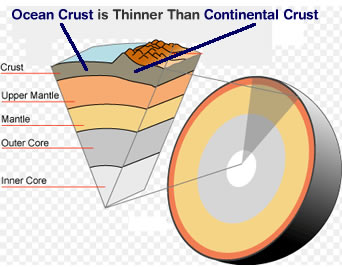Despite the information available about the surface of our planet, comparatively little is known about the state and composition of its inaccessible interior. The deepest boreholes (about 10km) hardly scratch the Earth's outer skin and the deepest known samples of rock, nodules of un-molten material brought up in volcanic lavas, come from a depth of only about 100km, just 1.5 per cent of the distance to the center.
Our knowledge of the deeper interior relies on indirect evidence from physical measurements of the Earth's mass, volume and mean density, observations of seismic waves that have passed through the deep interior, observations of meteorites and other bodies in the Solar System, experimental studies of natural materials at the high pressures and temperatures of the Earth's interior, and studies of the Earth's magnetic field.
Structure of Earth's Interior
 The Earth's mean density is 5,520kg/m3, whereas the densities of surface rocks lie in the range 2,500-3,000kg/m3.
The Earth's mean density is 5,520kg/m3, whereas the densities of surface rocks lie in the range 2,500-3,000kg/m3.
Density obviously increases with depth, but this increase alone need not imply changes in state or composition because the density of any material increases under compression, and pressure must increase with depth.
Seismic waves passing through the Earth's interior have revealed two major and three relatively minor discontinuities where changes in chemical and physical state occur. This data also helps to determine the density and elastic properties of the materials through which the waves pass, since these properties govern wave velocities.
The seismic discontinuities are broadly concentric with the Earth's surface; they therefore mark the boundaries of spherical shells with successively greater density - the major subdivisions into crust, mantle and core occur at the Mohorovicic and Gutenberg discontinuities.
The crust varies in thickness from about 7km in oceanic areas to about 40km under the continents and the mantle extends down to 2,900km. It contains a low-velocity layer which lies between 50 and 200km below the surface, where seismic wave velocities are reduced by a few per cent, and it is most prominent and shallow beneath oceanic areas.
The mantle also has a transition zone (from 400 to about 1,000km under the surface), which is characterized by several sharp increases in wave velocity and density with depth.
The Earth's core is subdivided into outer and inner regions by a minor discontinuity at a depth of about 5,100km; the outer core does not transmit seismic shear waves and is the only totally fluid layer in the Earth.
The Mantle
The combined evidence from volcanic nodules, exposed thrust slices of possible mantle rocks, physical data and meteorite studies, indicates that the upper mantle is made of silicate minerals. Among these minerals dark green olivine predominates, together with lesser amounts of black pyroxene, iron silicates and calcium aluminum silicates in a rock type known as peridotite.
Because temperature increases rapidly with depth in the outer 100 to 200km of the Earth, there comes a point (at about 1,500°C) at which peridotite starts to melt. The presence of partial melt accounts for the low-velocity layer and basalt magmas that erupt, particularly from oceanic volcanoes.
Because olivine has the highest melting temperature of the silicate minerals in peridotite it remains solid while other, less abundant, minerals contribute preferentially to the melt.
Temperature increases less rapidly with greater depth than does the melting point, so no further melting occurs at extreme depth although the hot, solid material is susceptible to plastic deformation and convects very slowly. This part of the mantle is the asthenosphere, or weak layer, which is distinct from the rigid uppermost mantle and crust, or lithosphere.
Increasing pressure is responsible for the transition zone where several rapid increases in density are probably caused by changes in the structure of the solids. In this zone the atomic structures of the compressed silicate minerals change to new forms in which the atoms are packed together more closely to occupy less volume. These new forms are thought to persist down to 2,900km.
Earth's Core
A marked physical and chemical change occurs across the core-mantle boundary - from solid to liquid, from a density of 5,500kg/m3 to one of 9,900kg/m3 and from silicate to almost pure iron.
Evidence of an iron-rich core is substantiated by iron meteorites and by observations of rapid variations of the Earth's magnetic field which require a mobile, electrically-conducting source.
The observed outer core density is slightly too low for pure iron, however, and is thought to comprise a mixture of 10 per cent sulfur and 90 per cent iron.
In the inner core, this situation is reversed and because a heavy element must accompany iron, the mixture is thought to be 15 per cent nickel and 85 per cent iron alloy. Because iron-sulfur mixtures melt at lower temperatures than do iron-nickel alloys, these compositions are consistent with the transition from liquid to solid across the outer-inner core boundary.